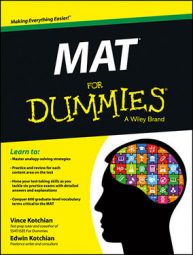MAT stands for Miller Analogies Test, and it is used for graduate school admissions. The format of the Miller Analogies Test is simple. During the MAT, you have 60 minutes to answer 120 questions, all of which are analogies. In each question, part of the analogy is missing. Your job is to pick the correct choice out of four possibilities to complete the analogy.
Sounds simple, right? Well, it’s a bit more complicated than that. Much like Trivial Pursuit, the MAT tests your knowledge of a wide variety of subjects, ranging from astronomy to math, to vocabulary, to zoology — and everything in between.
When you realize just how many subjects the MAT potentially covers, you may be a little discouraged — after all, you’re not a walking Wikipedia, nor are you Alex Trebek or the host of any other brainiac TV trivia program (at least, probably not).
But don’t worry — the MAT doesn’t require you to know everything about the subjects it covers. If you have some time to prepare, you can significantly increase your knowledge of the subjects you’re less familiar with. And you’ll be able to learn how to intelligently attack analogy questions.
If you’re browsing this website for articles on the MAT, you’re off to a great start in preparing to take the Miller Analogies Test. Another good reference for the MAT is the test publisher’s website, which has current information about the test.
The site has a Candidate Information Booklet that contains much of the info you’ll need. Browse as much of the site as you can: As G. I. Joe said, knowing is half the battle. Perhaps most important, the site has a link for purchasing three full-length computer-based MAT practice tests. These tests can (and should) become part of your preparation plan.
As previously mentioned, the MAT has 120 questions, all of which are analogies. For the purposes of the MAT, an analogy is a relationship between two pairs of terms. For example:
Big is to small as fast is to slow.
The relationship between the terms big and small is similar to the relationship between the terms fast and slow — they’re both opposites. As you’ll learn, several types of relationships between analogy terms show up on the MAT.
If, like most people, you’re taking the MAT on a computer, you’ll see only one question at a time. Each question looks like the following example:
FISH : SCALES :: BEAR : _________________
(A)feathers
(B)fur
(C)spines
(D)wool
This analogy includes four terms: FISH, SCALES, BEAR, and then one of the multiple choices (a. feathers, b. fur, c. spines, d. wool).
The part of the question enclosed in parentheses (a. feathers, b. fur, c. spines, d. wool) can appear as any of the four terms. For example, the question can be rewritten as follows:
_________________ : BEAR :: FISH : SCALES
(A)feathers
(B)fur
(C)spines
(D)wool
Your job is to pick the choice that makes the first and second terms have the same relationship to the third and fourth terms, or to make the first and third terms have the same relationship as the second and fourth terms. If you pick Choice B, fur, as the missing term, then a logical analogy is formed:
A fish is covered with scales, like a bear is covered with fur.
As the MAT progresses, the questions get harder and the topics vary, but you can be sure that analogies will be the only question type you’ll encounter.

